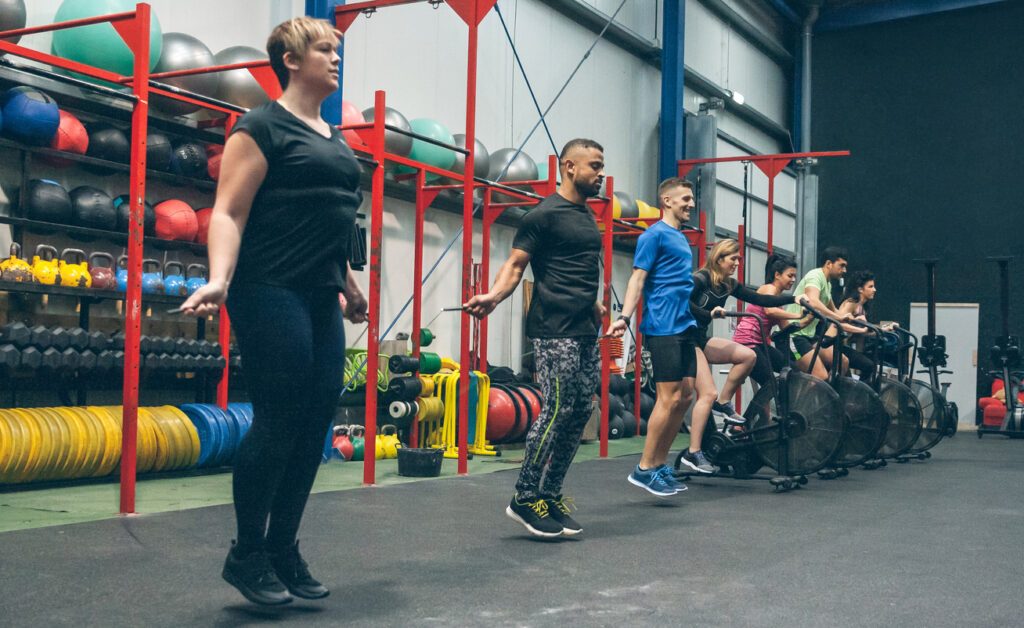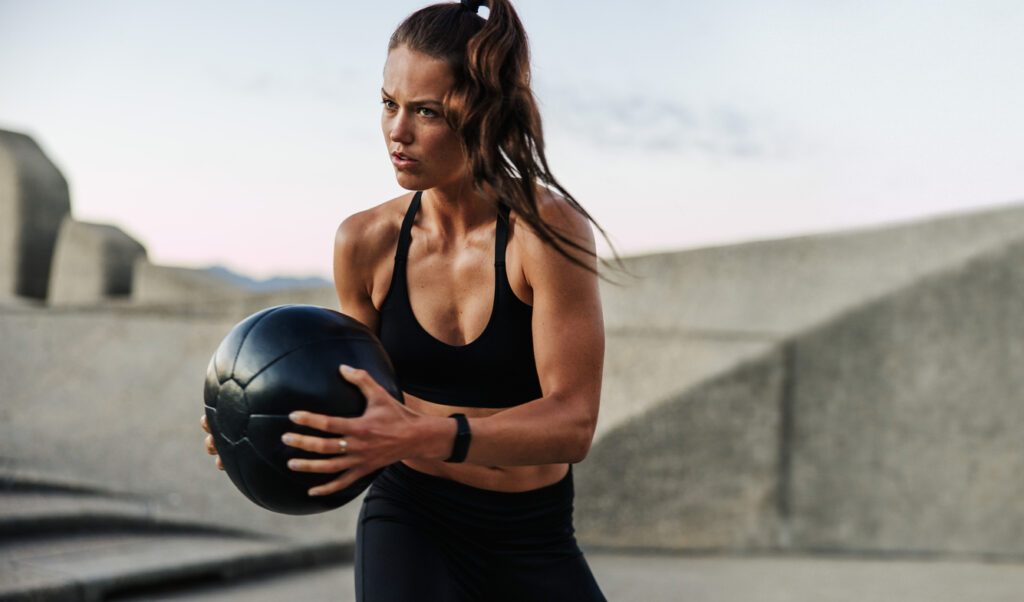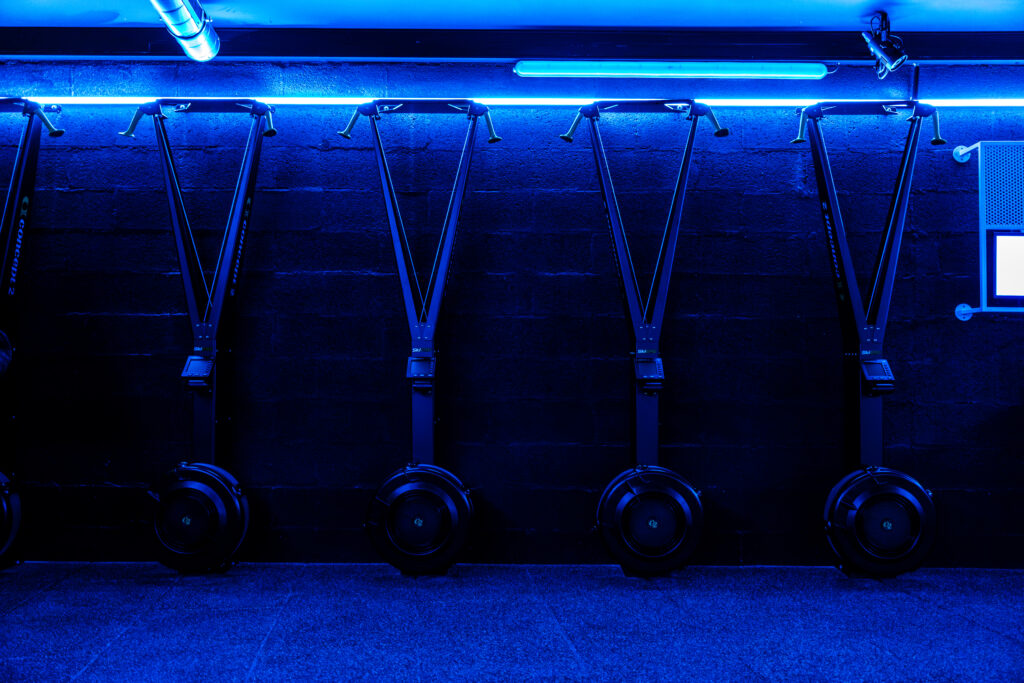
Summary
Welcome / Welcome / Tips for getting started / HYROX preparation: effective strategies to perform on D-day
HYROX preparation: effective strategies to perform on D-day
If you are preparing to take up the challenge of theHYROXyou are about to take part in one of the the most demanding competitions from the world of fitness. HYROX combines 8 kilometres of running with 8 intensive functional exercises, putting your fitness to the test. endurance, your strength and your ability to manage rapid transitions between different types of effort.
Preparing for such an event is essential, not only to optimise your performance, but also to avoid injury. In this article, we're going to explore some effective strategies to help you with your HYROX preparation. You'll find out how to design a personalised training programme, integrate cross training and weight training into your routine, tips on how to get the most out of your HYROX training, and more. nutrition and recovery techniques, as well as tips for maximise your performance on D-Day.
Summary
Introduction to HYROX
Introducing HYROX
HYROX is an innovative fitness competition that combinesendurance HYROX combines running with a series of functional exercises, all structured in a unique running format. Designed to test various aspects of fitness, HYROX includes 1 kilometre running intervals alternating with functional exercise stations. This structure makes it possible to assess strength, there staminaand endurance, providing a comprehensive measure of participants' fitness levels.
HYROX was created by Christian Toetzke And Moritz FürsteHYROX, with the aim of offering a fitness competition accessible to a wide range of enthusiasts, from beginners to elite athletes. The first HYROX was held in Hamburg, Germany, and since then the event has grown rapidly on a global scale. Today, there are more than 40 races organised on three continents and in 11 countries.
Examples of exercises
HYROX includes a variety of demanding functional exercises designed to test different physical abilities. Here are just a few examples of the exercises that participants must complete:
- SkiErg : Participants must perform cross-country skiing movements on a machine to cover a distance of 1000 metres.
- Sled Push and Sled Pull : These exercises require intense lower-limb strength to move heavy weights over a distance of 50 metres.
- Burpee Broad Jumps : This combination of exercises requires power explosive and endurance over a distance of 80 metres.
- Rowing : Participants have to row a distance of 1000 metres, testing their cardiovascular and muscular endurance.
- Farmers Carry : This exercise targets the strength of the grip and the stamina over a distance of 200 metres.
- Sandbag Lunges : These exercises work the leg muscles and balance over a distance of 100 metres.
- Wall Balls : Participants have to make a number of throws of weighted balls to a target height, requiring coordination, strength and endurance.
These exercises, alternated with running intervals, create a complete and varied challenge that pushes participants to their physical and mental limits. This invigorating event requires rigorous discipline and a solid training base to successfully manage the sequence of intense efforts at all levels of athleticism.
Why prepare HYROX?
Physical and mental challenges
The preparation for HYROX is indispensable because of the physical and mental challenges intense that this competition has to offer. HYROX combines elements of running and functional exercise, requiring a high level of fitness. exceptional overall physical condition.
Participants face challenges such as Sled PushBurpee Broad Jumps, Rowing and Farmer's Carry, which combine strength, endurance and agility. These physical challenges are accompanied by significant mental challengesThis is because participants have to cope with fatigue, stress and intense effort over an extended period.
The ability to maintain a concentration and determination is essential to overcome the obstacles and reach the finish line.
Improved endurance, strength and agility
Preparation with HYROX offers many advantages benefits in terms of improving endurance, strength and agility. The combination of running and functional exercises strengthens the cardiovascular systemIt improves breathing capacity and develops balanced musculature.
The varied exercises, such as pull-ups, lunges and weight-bearing, target several muscle groups, promoting overall development of strength and muscular endurance. What's more, HYROX improves agility and coordination by challenging rapid transitions between different types of exercise.
This variety of movement and intense effort helps to develop a sense of well-being. better mobility and improved coordination, essential for progress in sport and everyday life.
Mental development
Preparing for HYROX is not only physical, but also mental. This competition requires a strong mental resilienceThis is because participants have to learn to cope with fatigue, stress and intense effort.
Mental preparation includes techniques such as meditation, visualisation and breath management, all of which help to keep you on track. calm and concentrated under pressure. The preparation process and participation in HYROX strengthen the self-confidence and self-esteem.
Every success and every advance made during preparation and during the competition contributes to the development of a strong team spirit. positive mentality and resilient, useful not only in the sporting context but also in everyday life.
How to prepare for HYROX?
Preparing for HYROX requires an approach structured and personalised. It is essential to start with a full assessment your physical condition to identify your strengths and areas for improvement.
A tailored training programme, including running sessions, functional exercises and muscle-strengthening sessions, is essential to prepare for the specific challenges of HYROX. In addition, the support of an experienced coach or trainer can provide detailed advice and constant motivation, helping to adjust the intensity of training and master the techniques needed to excel in each event.
Group or individual sessions, as well as advice from nutrition and recovery, are also essential for complete and effective preparation.
Examples of sessions:
Running with intervals.
To prepare for theHYROXIt is important to include sessions of interval running in your training programme. These sessions are designed to improvecardiovascular endurance and the ability to manage fatigue during transitions between functional exercises.
An example of a session could be as follows:
- Monday : Endurance - 4 rounds of 400 metres of running, followed by 1 minute's rest between each round.
- Incorporate speed intervals, for example, 1 kilometre of running followed by 1 minute of walking or rest, repeated 8 times.
This training structure makes it possible to simulate fatigue conditions and transitions present in the HYROX competition, where participants have to alternate between running and functional exercises.
Functional training (Sled Push, Wall Balls).
L'functional training is an essential part of HYROX preparation. Functional exercises such as Sled Push and the Wall Balls are specifically designed to simulate competition events.
Here is an example of a functional training session:
Tuesday : Endurance - 45 minutes of AMRAP (As Many Reps As Possible) including :
- 50 metres of Sled Push
- 50 metres of Sled Pull
- 50-metre run
- 40 Wall Balls
This session is an opportunity to work on the strength, l'endurance and the coordination under fatiguekey to HYROX performance.
These functional exercises need to be incorporated into your training programme on a regular basis to get you used to the new techniques. specific movements and the associated fatigue.
Strength training (squats, lunges).
L'strength training is vital for strengthening the muscles needed for functional exercise and running. Squats, lunges and other strength exercises target the muscle groups essential for HYROX performance.
An example of a strength training session could be :
Wednesday : Strength - 4 rounds of :
- 100-metre Sandbag Walking Lunges
- 50 metres of Sled Push
- 100 metres of sandbag squats
Incorporate strength exercises such as squats, lunges and deadlifts to strengthen leg, back and shoulder muscles. These strength sessions should be structured to specifically target muscle groups used during the competition, to maximise performance and minimise the risk of injury.
Training at home
Benefits
L'home training for HYROX offers a number of significant advantages. Firstly, it is accessible and doesn't require expensive equipment, making it ideal for those who don't have regular access to a gym. Sessions can include HYROX preparation exercises such as burpees or rowing, adapted for all levels, whether you're a beginner or an experienced athlete.
What's more, training at home allows you to great flexibility in terms of planning. You can train at any time of day, according to your preferences and schedule. It also reduces the stress associated with traffic or gym timetables, which improves your motivation and your regularity in training.
Advice
To maximise the benefits of your home training, it's essential to follow a few key tips. First of all, make sure you warm up properly before each session. Dynamic exercises such as jumping jacks, lunges and light squats are perfect for preparing your body for the intense effort that follows.
It is also important to manage your pace and not to start too quickly, especially in long sessions such as the AMRAP (As Many Reps As Possible). Maintaining a steady pace from the start will help you avoid premature exhaustion and finish your session efficiently.
Finally, focus on the technique exercises. Good posture and correct execution of movements will reduce the risk of injury and improve your performance. If certain exercises are too difficult, adapt them, for example by starting push-ups on the knees or adding water packs for lunges.
Essential Techniques for HYROX Exercises
HYROX includes a variety of functional exercises that require specific techniques to be carried out efficiently and safely. Here are some essential techniques to master:
SkiErg and Rowing : Arm-leg coordination
SkiErg and Rowing are exercises that test the coordination between the arms and legs. For SkiErg, it's important to maintain an upright posture and synchronise your arm and leg movements to maximise efficiency. For Rowing, the technique consists of starting in a bent-knee position, followed by a pulling movement of the arms while extending the legs, then returning to the initial position by synchronising the movements.
Sled Push and Pull : Efficient pushing and pulling technique
The Sled Push and Sled Pull are exercises that require precise technique. For the Sled Push, maintain an upright posture, engage your hips and use the strength of your legs to push the sled. For the Sled Pull, use a firm grip and pull the sled towards you, engaging your shoulders and back.
Burpees and lunges : Perfect shape to prevent injury
Burpees and lunges are fundamental HYROX exercises that require perfect form to avoid injury. For burpees, start in a standing position, squat down, do a push-up, then jump into the air while keeping your chest straight. For lunges, maintain a good range of movement, keep your torso straight and make sure that the knee of the front leg does not extend beyond the toes.
By mastering these techniques, you can optimise your performances and reduce the risk of injury during your home training sessions.
Nutrition and recovery
Balanced diet
A balanced diet is essential for optimising performance and speed up recovery when preparing for HYROX. Nutrition plays a critical role in supporting endurance, strength and muscle recovery.
Key Macronutrients
Carbohydrates : Carbohydrates are the body's preferred source of energy, particularly important for high-intensity activities such as HYROX.
We recommend consuming complex carbohydrates such as wholegrain cereals, sweet potatoes and oats, around 2-3 hours before training or competition. Simple carbohydrate sources such as bananas, dates or energy gels can be useful during long sessions for a quick energy boost.
Proteins: Proteins are essential for muscle repair and growth.
Athletes involved in intense hybrid training should aim to 1.6 to 2.4 grams of protein per kilogram of lean body mass. Include lean protein sources such as chicken, fish, eggs, tofu and whey protein in your diet.
Fats : Healthy fats, such as those found in avocados, nuts, seeds and olive oil, are essential for energy, hormone production and immune function. They should represent 25-35% of your total calorie intake.
Hydration: Hydration is vital for maintaining performance and energy levels. speed up recovery.
Drink water regularly throughout the day and include electrolytes (sodium, potassium, magnesium) during long, intense sessions to replace what is lost in sweat. Progressive dehydration can lead to an increase in plasma osmolality, a reduction in blood volume and altered thermoregulation, which can cause muscle cramps, reduced neuromuscular function and cognitive impairment.
Active recovery
There active recovery is an important part of HYROX preparation, helping to repair muscles, replenish energy reserves and maintain optimum performance.
Recovery Nutrition : After an intense training session, it's essential to consume a combination of carbohydrates and proteins in the right quantities. 30-60 minutes depending on the exercise. This helps repair muscles and replenish glycogen stores. An example of a recovery snack could be a protein shake with a banana or Greek yoghurt with granola.
Recovery activities : Active recovery activities such as light walking, yoga or swimming can help to improve blood circulation and reduce muscle pain.
These activities should be carried out at a low intensity to avoid overloading already tired muscles.
Rest and sleep : Rest and sleep are essential for muscle recovery and tissue regeneration.
Make sure you get enough sleep every night and take active rest periods between intense training sessions. Quality sleep and adequate rest periods help maintain the immune system and prevent injury.
By incorporating these nutrition and recovery strategies into your training routine, you can optimise your performance, speed up your recovery and prepare you effectively for HYROX.
Tips for Competition Day
Mental preparation: Visualisation and stress management
There mental preparation is an important part of performing at your best in a HYROX competition. The view and stress management are essential tools for maintaining concentration and confidence throughout the event.
Visualisation
Visualisation is a technique which involves imagining yourself succeeding at each stage of the competition. Before race day, take a few moments to visualise each exercise station and each segment of the race. Imagine yourself performing the Burpee Broad Jumps with fluidity, pushing the sled with strength and finishing each kilometre of the race at a good pace.
This practice can strengthen your trust and reduce anxiety, allowing you to approach the competition in a positive frame of mind.
Stress management
Stress management is also vital for maintaining a positive mental state. Use techniques to deep breathYou'll be able to use a variety of techniques to calm your nerves before and during the competition, such as meditation or muscle relaxation.
It's important to remain calm and focused, even in the face of pressure and fatigue accumulated over the course of the event. A positive mentality and resilient will help you overcome obstacles and maintain peak performance.
Physical preparation: Proper warm-up and hydration
Adequate physical preparation is essential to avoid injury and optimise performance on the day of the competition.
Proper warm-up
Arrive at the venue early so that you have enough time to warm up properly. A good warm-up should include dynamic exercises such as jumping jacks, light lunges and shoulder rotations. These movements increase blood circulation, warm up the muscles and prepare your body for the intense effort that follows.
You can also use the equipment available on site to do light repetitions of exercises specific to HYROX, such as SkiErg or Rowing. This will allow you to familiarise yourself with the movements and sensations before the competition.
Hydration
Hydration is essential to maintain performance and avoid dehydration. Drink water regularly throughout the day before the race and include electrolytes to replace what is lost in sweat.
On race day, make sure you drink water and electrolyte drinks 30 minutes to 1 hour before the start. Continue to drink small amounts of water and electrolytes during breaks between exercise stations. Good hydration helps to maintain your energy and prevent muscle cramps and other problems associated with dehydration.
By following these mental and physical preparation tips, you'll be better equipped to face the challenges of HYROX and achieve your performance goals.
Conclusion
In conclusion, preparation for HYROX requires an approach based on holistic which combines physical trainingbalanced nutrition and active recovery. It's essential to understand the structure of this competition, which alternates between 1 kilometre races and particularly demanding functional exercise stations.
A well-structured training programme, including sessions of strengthendurance and functionality, is indispensable to meet the challenges of HYROX. What's more, a balanced diet and adequate hydration are vital to optimising your performance and speeding up recovery.
Mental preparation, particularly through view and stress management, can also play a key role in improving your results. Don't hesitate to incorporate HYROX into your training routine and enter a competition. Whether you're an experienced athlete or a novice, HYROX offers a unique experience and accessible to all fitness levels.
So take up the challenge, start your preparation today and discover the processing benefits HYROX for your physical fitness and overall well-being.
FAQs
What type of functional training is best suited to preparing for a HYROX event?
To prepare for a HYROX event, it's essential to focus on one thing functional training which combines endurance, strength and mental resilience. Key exercises include:
- SkiErg To exercise the upper body.
- Sled Push And Sled Pull : To test strength and endurance.
- Wall Ball To develop explosiveness.
- Farmer's Carry To strengthen the muscles as a whole.
These exercises, alternated with running segments, simulate the conditions of the event while improving muscular performance and physical condition.
How can I incorporate running into my HYROX training programme?
To incorporate running into your HYROX training programme, start by varying your sessions:
- Build your endurance with long-distance races.
- intervals to improve your speed. Finish off with some hill sprints to develop your power.
Include regular sessions alternating between endurance, speed intervals and hill sprints. This will help you maintain a steady pace throughout the 8-kilometre HYROX race.
What equipment and materials are essential for starting and progressing with HYROX training?
To progress with HYROX training, a number of items of equipment are essential:
- Barbell and plates For developing strength and endurance, particularly for exercises such as the Farmer's Carry and squats.
- Treadmill or running space: To improve running endurance, which represents 50% of the HYROX competition.
- SkiErg And RowErg To target overall endurance and strength in the arms, shoulders and core.
- Sleds and resistance tools: For workstations such as the Sled Push.
- Wall Balls And Sandbags For exercises such as the Wall Ball Shot and Sandbag Carry.
How do you manage nutrition and hydration before and during a HYROX competition?
To optimise your nutrition and hydration before and during a HYROX competition, here are the key steps:
- Before the race Eat a meal rich in complex carbohydrates (such as oatmeal, sweet potatoes or brown rice) 2-3 hours beforehand. Add moderate protein and limit fat and fibre to avoid gastrointestinal problems.
- Hydration Drink regularly throughout the day, including electrolytes for long, intense sessions.
- During the race Use energy gels or sports drinks to maintain your energy levels and stay hydrated. Test these strategies during training to avoid any discomfort.
- After the race Eat a quick meal or snack containing carbohydrates and protein to promote muscle recovery and replenish your glycogen reserves.
Share
Tagged
Read also
follow us
on instagram
To follow all our news,
take advantage of our tutorials and participate
in our many competitions.
BREAKING NEWS!
Receive our newsletter.




